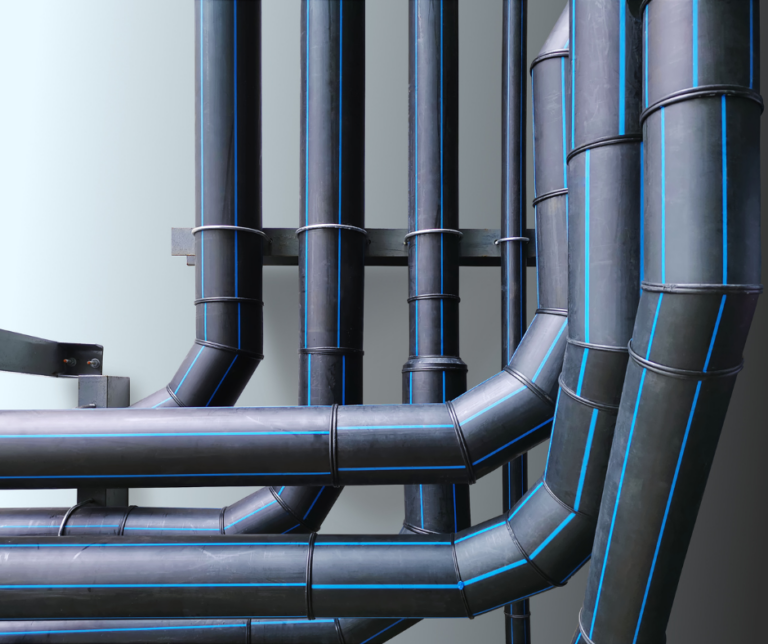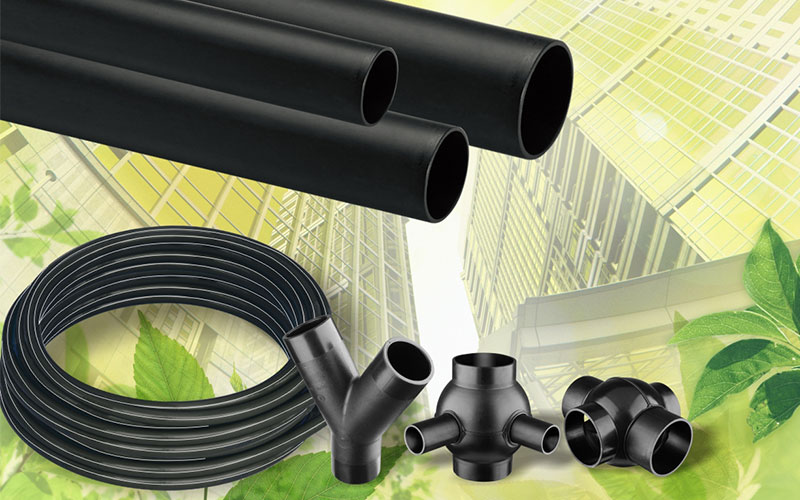The Role of Pipe Manufacturing Midland TX in Driving Local Projects
Wiki Article
Explore the Manufacturing Refine Behind High-Quality HDPE Pipe and Its Applications
The production procedure of top quality HDPE pipelines is complex and methodical. It starts with the option of raw products that improve performance. Following this, ethylene undertakes polymerization to create resin, which is then formed via extrusion. Quality assurance is paramount, making sure that the last product satisfies stringent requirements. The journey of HDPE pipelines doesn't end with manufacturing. Their applications throughout different markets disclose a more comprehensive importance worth checking out.Comprehending HDPE: Residences and Advantages

High-density polyethylene (HDPE) is a flexible polycarbonate recognized for its sturdiness and resistance to numerous environmental aspects. This product shows superb tensile toughness, making it suitable for requiring applications. Its low-density framework adds to a lightweight item, promoting ease of taking care of and setup. HDPE likewise showcases impressive resistance to chemicals, which reduces deterioration when exposed to severe compounds.
The product's reduced wetness absorption better boosts its long life, making it optimal for usage in pipelines and tank. Furthermore, HDPE is immune to ultraviolet (UV) radiation, making sure that products keep their integrity also when revealed to sunshine. Its flexibility permits for the creation of elaborate shapes without endangering strength. The eco-friendly nature of HDPE, usually acquired from recycled products, contributes to its allure, promoting sustainable methods in manufacturing. On the whole, these buildings and benefits make HDPE a favored choice for various industrial and consumer applications.
Resources Choice for HDPE Manufacturing
The choice of resources for HDPE manufacturing is important to confirm the last item meets the preferred requirements and high quality standards. High-density polyethylene (HDPE) is primarily created from polymerized ethylene, stemmed from nonrenewable fuel sources such as natural gas or petroleum. The quality of these feedstocks substantially affects the mechanical and thermal buildings of the final HDPE.Additives also play a significant function in enhancing HDPE's efficiency, including antioxidants, UV stabilizers, and colorants, which improve durability and resistance to ecological variables. The selection process have to take into consideration not only the chemical structure of the raw materials however likewise their processing features to ensure efficient production.
The sourcing of raw materials need to prioritize sustainability and compliance with ecological laws, as responsible methods are important in today's market. Eventually, mindful resources option lays the foundation for generating premium HDPE pipelines ideal for diverse applications.
The Extrusion Process: Forming HDPE Pipeline
The extrusion procedure plays an important duty fit HDPE pipelines, beginning with careful product preparation methods that guarantee perfect circulation and consistency. Just as important is the style of the die, which directly affects the last measurements and surface high quality of the pipeline. With each other, these aspects add significantly to the efficiency and top quality of HDPE pipe manufacturing.Product Prep Work Strategies
Reliable manufacturing of HDPE pipes begins with meticulous product prep work techniques, especially the extrusion process. During this phase, high-density polyethylene material is very first dried to get rid of moisture, making sure ideal circulation qualities. The resin is after that fed into the extruder, where it goes through home heating and melting, transforming into a thick state. This heating process is meticulously controlled to maintain the product's integrity and performance. The liquified HDPE is forced via a die, forming it into a continuous pipe kind. Appropriate temperature level administration throughout extrusion is crucial, as it directly affects the material's properties and the end product top quality. Once formed, the HDPE pipe is cooled down and reduced to defined sizes, all set for succeeding handling and applications.Die Style Relevance
Accuracy in die style plays a necessary duty in the extrusion procedure of HDPE pipelines. The die serves as the last shaping device, straight affecting the pipeline's dimensions, wall thickness, and surface finish. A properly designed die warranties uniform material circulation, decreasing issues such as irregularities and weak points. The geometry of the die should be optimized to fit the particular properties of HDPE, including its viscosity and thermal behavior throughout extrusion. Additionally, the cooling price of the material as it passes via the die can significantly impact the pipe's structural honesty. Investing in innovative die technology is crucial for makers intending to create top quality HDPE pipes that meet industry criteria and customer assumptions.Quality Control Measures in HDPE Manufacturing
Different variables affect the quality of HDPE pipeline manufacturing, effective top quality control measures are important to assure uniformity and dependability in the last product (Pipe Manufacturing Midland TX). Key quality control methods include rigorous material assessment, validating that the raw polyethylene satisfies recognized requirements for pureness and density. During the extrusion process, criteria such as temperature, stress, and cooling time are closely kept track of to maintain dimensional accuracy and structural honestyAdditionally, post-production screening is crucial; makers typically perform hydrostatic tests to evaluate the pipe's stamina and resistance to stress. Visual assessments for surface flaws further enhance quality control. Accreditation from relevant requirements organizations, like ASTM or ISO, gives an additional layer of integrity. By carrying out these complete quality assurance steps, suppliers can decrease problems, improve performance, and make certain that the HDPE pipelines meet the particular demands of various applications, inevitably bring about customer fulfillment and count on the item.
Applications of HDPE Pipe Throughout Industries
HDPE pipelines are used throughout see it here different sectors because of their longevity and convenience. In water distribution systems, they ensure reliable shipment, while in wastewater monitoring, they supply reliable services for waste transport. Furthermore, farming irrigation networks take advantage of HDPE's resistance to deterioration and flexibility, making it an excellent choice for modern farming practices.
Water Distribution Solutions
A substantial number of industries count on high-density polyethylene (HDPE) pipelines for reliable water distribution systems. Recognized for their longevity and resistance to corrosion, HDPE pipes are commonly utilized in local water networks, farming irrigation, and commercial applications. Their lightweight nature promotes very easy handling and installation, decreasing labor expenses and time. Furthermore, HDPE pipes can fit different pressure levels, making them appropriate for both low and high-pressure systems. Texas hdpe pipe manufacturer. The flexibility of the material enables for seamless combination into existing facilities, minimizing the need for substantial excavation. HDPE's resistance to chemical seeping warranties that the water delivered remains risk-free and tidy, making it a perfect option for preserving the top quality of safe and clean water throughout different markets.Wastewater Monitoring Solutions
Effective water circulation systems also lead the way for ingenious wastewater administration services, where high-density polyethylene (HDPE) pipelines play a significant function. Renowned for their resilience and resistance to corrosion, HDPE pipelines are optimal for transporting wastewater in different setups. Their versatility permits for very easy setup in complex atmospheres, minimizing the demand for substantial excavation. Additionally, HDPE's smooth interior surface decreases rubbing, enhancing circulation rates and performance. These pipelines are additionally immune to chemical leaching, making sure that impurities do not endanger the surrounding atmosphere. Industries, towns, and treatment facilities progressively depend on HDPE pipes for their reliability and longevity, making them a preferred option for contemporary wastewater administration systems. This versatility emphasizes the critical value of HDPE pipelines across many applications.Agricultural Watering Networks
Agricultural watering networks benefit substantially from using high-density polyethylene (HDPE) pipes, which supply effective and trusted water distribution to crops. HDPE pipes are lightweight, making them very easy to transport and set up, while their adaptability permits various configurations in diverse terrains. These pipes demonstrate outstanding resistance to deterioration, chemicals, and UV radiation, ensuring resilience in rough agricultural settings. Additionally, their smooth indoor surface area decreases friction loss, maximizing water circulation and reducing power costs related to pumping. The longevity of HDPE pipes, typically exceeding half a century, adds to reduce maintenance and substitute expenses. Farmers progressively rely on HDPE pipelines to boost watering efficiency and advertise lasting agricultural practices, eventually leading to enhanced plant returns and resource preservation.
Future Fads in HDPE Pipe Innovation
As the need for lasting and effective facilities grows, innovations in HDPE pipeline modern technology are positioned to change different industries. Arising trends include the combination of smart technologies, such as sensing units and IoT capabilities, which facilitate real-time tracking Clicking Here of pipeline conditions, lowering maintenance prices and stopping leakages. Additionally, the growth of innovative manufacturing methods, such as 3D printing, is allowing the production of complicated, personalized pipeline styles that satisfy particular project requirements.The emphasis on recycling and round economic climate methods is driving the technology of HDPE pipes made from recycled materials, improving sustainability. Enhanced jointing methods, such as electro-fusion and mechanical installations, are additionally boosting installment performance and reliability. Lastly, the expanding focus on environmental regulations is pushing producers to embrace greener production processes, making certain that HDPE pipelines not just fulfill sector standards however likewise promote an even more sustainable future for facilities growth.
Regularly Asked Concerns
How Does HDPE Compare to Various Other Plastic Products?
HDPE outshines several other plastic products pertaining to toughness, chemical resistance, and flexibility. Its low thickness and high tensile toughness make it excellent for various applications, often going beyond options in both performance and longevity.What Are the Ecological Effects of HDPE Production?
The ecological impacts of HDPE manufacturing include greenhouse gas emissions, power consumption, and installing gas line from street to house possible contamination from manufacturing procedures. Additionally, inappropriate disposal can result in dirt and water contamination, elevating problems regarding lasting environmental results.Can HDPE Pipes Be Reused?
Yes, HDPE pipes can be reused. Several centers approve utilized HDPE for handling, transforming it right into new items. This reusing contributes to sustainability initiatives, decreasing plastic waste while conserving resources and power in the production cycle.What Is the Life-span of HDPE Piping?

Just How Do Temperature Level Variations Affect HDPE Pipeline Efficiency?
Temperature level variations substantially influence HDPE pipe efficiency, influencing adaptability and strength. Heats can lead to softening, while reduced temperature levels might create brittleness, eventually influencing the pipe's resilience and viability for numerous applications in diverse settings.Report this wiki page